When Cooper and Lucca were eight and six years old, their dad, Nathan Greenawalt of Madison, Wisconsin, decided to build them a boat. Cooper had just started learning to sail in Optimist dinghies, and Nathan thought it would be fun for the brother and sister to have their own boat, but one that was a “little bigger, a little more stable, a little safer, a little cuter.”
Nathan had been introduced to both sailing and woodworking when he was 16. He had built some wooden tables at home, and when his family moved to a house on a small lake his brother bought an old fiberglass dinghy. The boys sailed it together, and when the wood trim needed fixing one summer, Nathan made the repair.
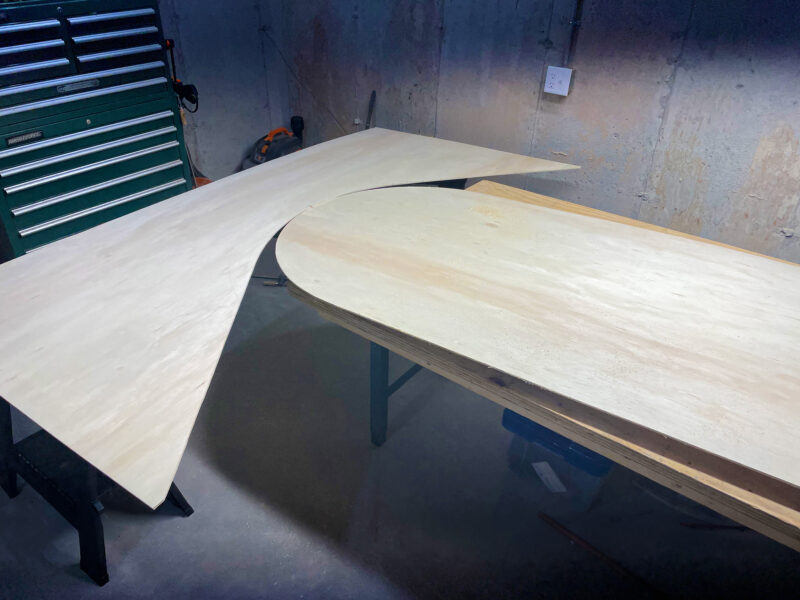 Photographs by Nathan Greenawalt
Photographs by Nathan GreenawaltNathan’s design called for a curved bow. Wrapping the plywood around the 40″-diameter arc drawn onto the bottom sheet caused him some headaches but he persevered.
In more recent years he bought a 26′ sailboat, which he sails with friends, and he’s done a bit of kayaking. And while there has been no more woodworking beyond the occasional repair around the house, Nathan had wanted to build a boat for as long as he could remember.
“I really wanted to build something from scratch, design it myself from the ground up,” he says, “but that seemed like a project I might never actually move forward with. So, one fall, I bought a stitch-and-glue kayak kit and set myself up in the basement of our house.” He built it over the winter and, by the end of a “really enjoyable project,” had a “great little boat.”
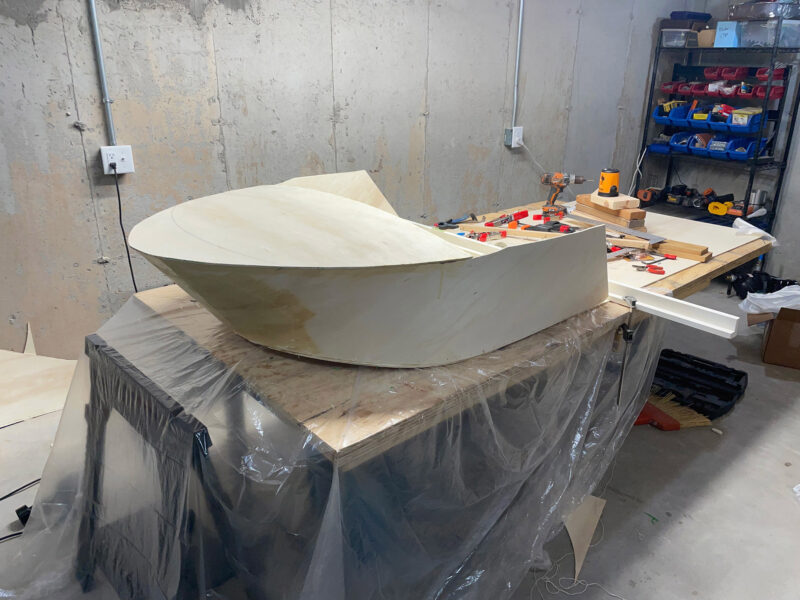
The foredeck, also curved, was cut from the same sheet of plywood as the bow. Wrapping the bow introduced a few minor cracks, but Nathan reinforced them with extra fiberglass and epoxy.
The experience whetted his appetite, and a year later Nathan was “ready to do my own design. I really wanted to go buy lumber and do it!”
Bringing a Homemade Plywood Sailboat to Life
Nathan loosely based his design around the Optimist. He wanted to keep things simple, and determined that the length should be no more than 8′, “so I could use one sheet of plywood for the bottom.” He also decided to use Optimist spars and sail for the rig. He drew a few loose sketches and went off to buy three sheets of 1⁄4″ plywood and a 4 × 8 sheet of 2″ pink insulation foam board.
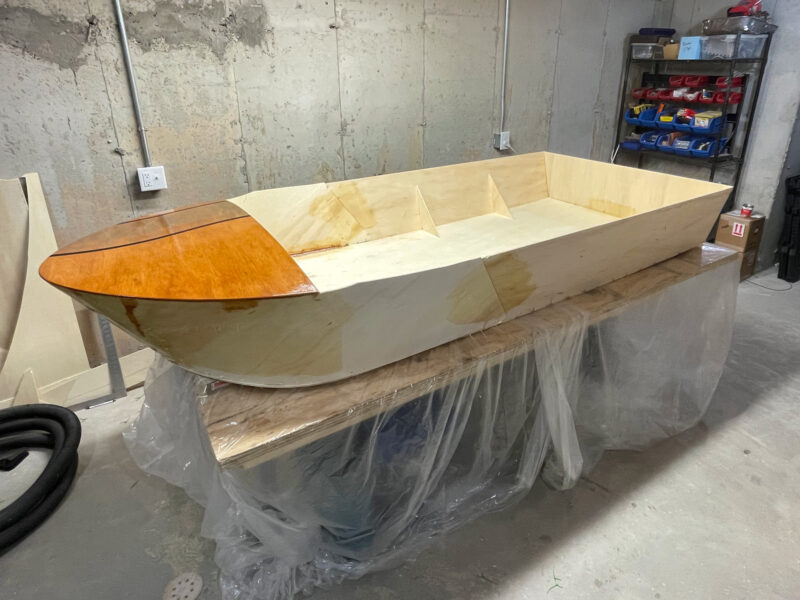
The side panels and side-to-bottom panel joint were strengthened by two standing knees on either side.
Nathan had in mind a stitch-and-glue, flat-bottomed plywood sailboat built of one sheet for the bottom, one for the bow and foredeck, and one for the transom and aft section of the two side panels.
The only tricky part of the construction, says Nathan, was the bow.
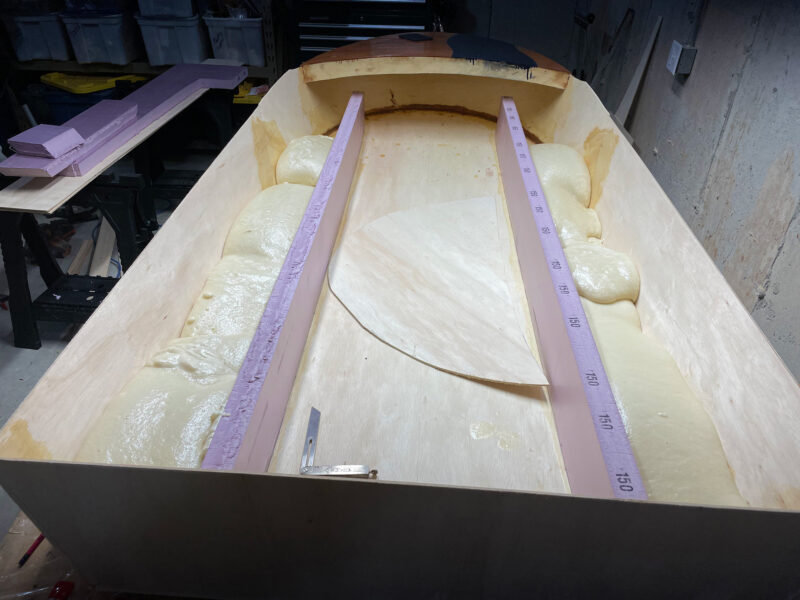
The interior faces of the bench seats were formed with foam board. Nathan filled the cavity between these and the outside panels with expanding polyurethane foam for flotation.
“I built that first. I wanted to create a nice curved, angled bow. It took me awhile to figure out the curve, but I worked out the beam of the boat, drew the curve on the bottom sheet of plywood, and cut it out. Then, I wrapped the bow sheet around and stitched it to the bottom panel as I went. Eventually I managed to make the 40″-diameter semicircle. There was some minimal cracking, but I reinforced those spots later with extra fiberglass. Once the plywood was completely wrapped around, I used a laser level to define the top edge, and cut it out.”
What Nathan hadn’t foreseen was that the arc of the bow would lift the forward end of the bottom panel and introduce some shape athwartships. “It worked out nicely,” he says, “but it was pure accident. I had expected the bottom to be completely flat, but there’s curve there too.”
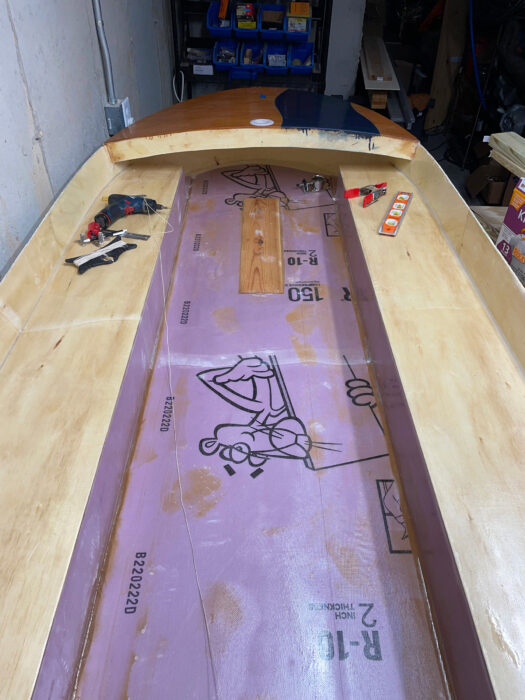
The bench seats were created with plywood tops and the bottom of the cockpit was lined with ’glassed and epoxied foam board. The daggerboard slot was reinforced with a solid alder block, which doubled as a mounting block for the maststep.
Once he had wrapped the bow panel, Nathan built the foredeck. Again, he wanted the deck to have a sweet curve and eyeballed it. He suspended a string from two pins, set apart by a distance equal to the beam, to create the arc he wanted and cut a deckbeam out of a leftover piece of plywood. He screwed and glued that to the sides, cut the deck panel out of what was left over of the bow sheet, and laid it across. The arched deck was quite rigid and required only the one deckbeam.
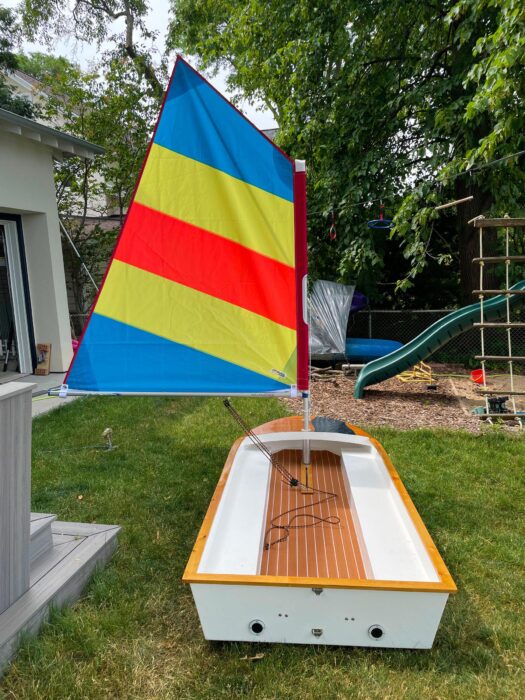
The finished boat. The foam traction sheet that lines the cockpit sole was added after a mishap with the rig. The spars and sail are standard Optimist-dinghy parts.
After that, Nathan’s boat was all straight edges. He stitched and glued the aft sections of the side panels, attached the transom, and then glued in some standing knees—two per side—to add some strength and rigidity to the sides. He wanted the cockpit to be more comfortable and less cluttered than the Optimist’s where the daggerboard and ’midship bulkhead divide the boat in two. He did away with a daggerboard trunk, opting instead to have the daggerboard set into a simple slot and, not wanting to sit on the floor or gunwale, he boxed in side benches, using pink foam board for their inboard faces and plywood for their tops. Before installing the tops, he filled the cavities with expanding polyurethane foam for flotation. He also laid foam board on the sole between the benches and for the length of the cockpit.
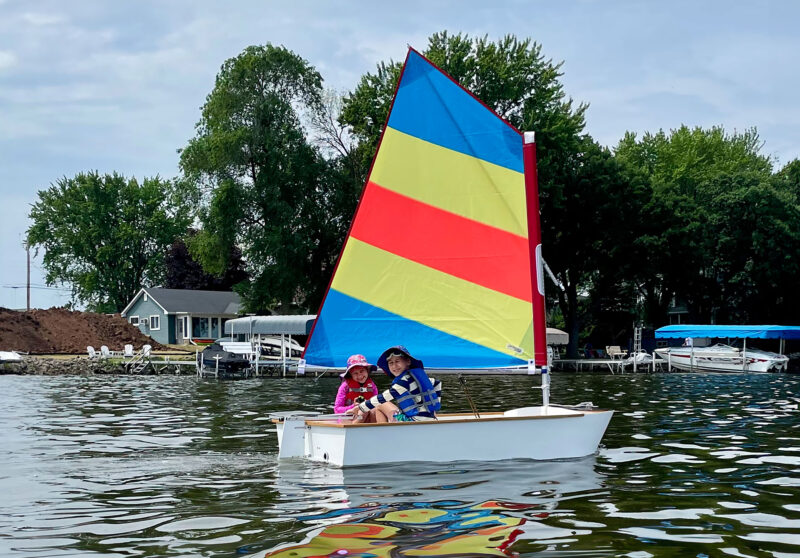
The uncluttered cockpit and full-length bench seats mean that Cooper and Lucca have plenty of space to sail together even though RIPPLE is only 8′ long.
With the interior nearly complete, he installed a block for the daggerboard slot and an adjustable stainless-steel maststep that makes it possible to adjust the rake of the mast to balance the rig. Nathan cut the slot for the daggerboard and reinforced it with offcuts of alder. Because the opening of the slot was above the waterline but low in the boat and would let water slop aboard occasionally, he cut two holes low in the transom for valved scuppers to make the cockpit self-draining. Everything was coated, inside and out, with ’glass and epoxy, and finished with epoxy paint and varnish.
Not wanting to get into designing and building sails and accessories, Nathan had bought Optimist parts: “the sail, the spars, the hardware for the rudder, everything.” By the time the boat emerged from the basement, the kids were ready to go. Rigging the boat for the first time was an exciting moment, but it was then that Nathan had his first mishap. “As I was getting everything ready, I dropped the sprit, and it pierced the epoxy, the ’glass, and the foam in the cockpit—right through to the plywood.”
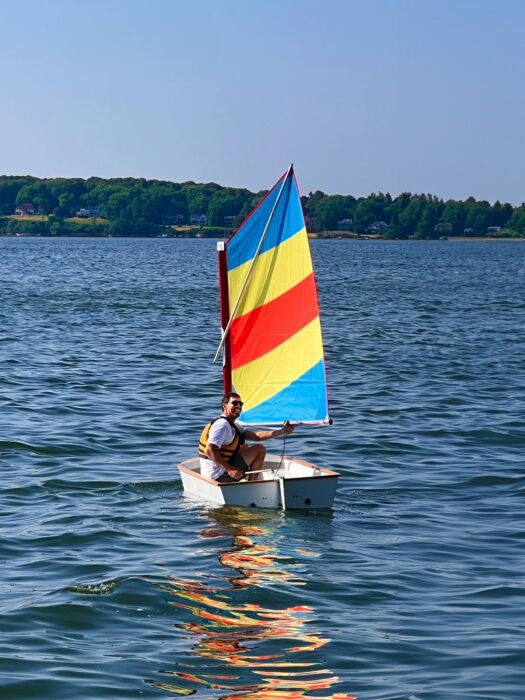 Courtney Greenawalt
Courtney GreenawaltNathan Greenawalt sailing RIPPLE on Lake Mendota, proving that three sheets of plywood, a simple rig, and a bit of determination are all it takes.
It was a low moment but a good wake-up: “It was pretty clear that I needed to reinforce the cockpit sole. But I didn’t want to add weight.” He fixed the hole and then laid a skin of self-adhesive EVA foam traction sheet on the sole. “It’s been great, looks good, protects the pink foam below from abuse, and it’s nonslip, which is a bonus.”
Since launching RIPPLE, named after the title of a Grateful Dead song, Nathan and the kids have used her at every opportunity on Lake Mendota. “She’s very stable,” he says, “With the kids sitting on the windward bench it would take a lot of wind to tip her over.” Even without the daggerboard trunk, RIPPLE rides high enough that the kids can go out on their own and stay dry. “If I go with them, water comes in through the slot, but it goes straight out through the scuppers so it’s just our feet that get wet.”
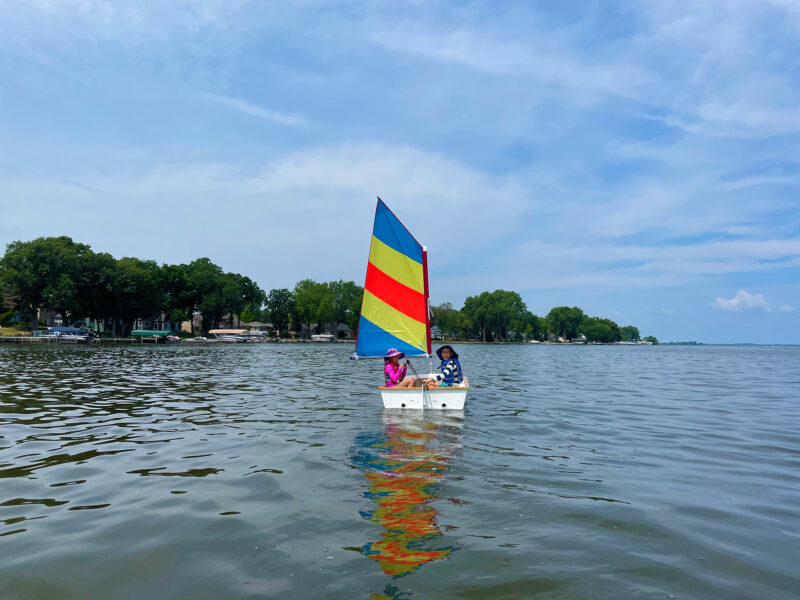
Cooper and Lucca sail RIPPLE together. With just the two of them in the boat everything stays dry. If Nathan joins them some water comes in through the daggerboard slot but drains out through the scuppers in the transom.
The family hasn’t yet sailed in company with an Optimist pram, but given that she’s a “touch longer and a touch shapelier,” Nathan thinks RIPPLE would be just a little faster. Cooper agrees. “She cuts through the water really nicely,” he says. “And she’s more comfortable than the Optimists.” Lucca, too, is happy with RIPPLE. “I like it because not very much water comes in,” she says. Nathan laughs, “Always important to keep the water out.” Cooper nods, “Dad did a good job.”![]()
Jenny Bennett is managing editor of Small Boats.
Do you have a boat with an interesting story? Please email us. We’d like to hear about it and share it with other Small Boats readers.
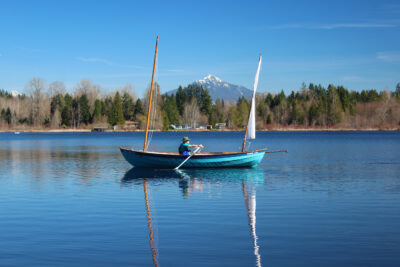
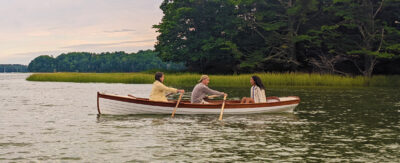
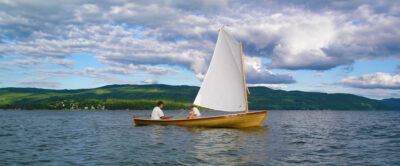
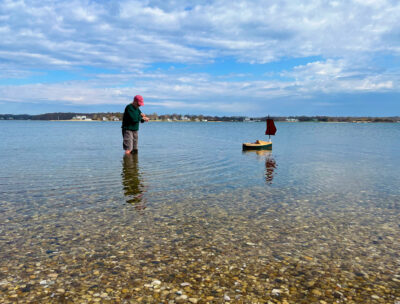
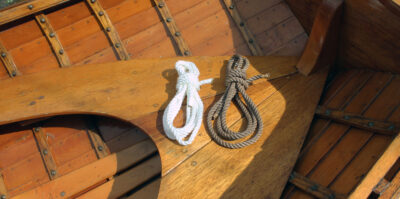
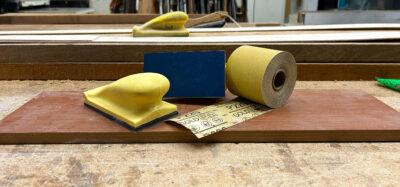
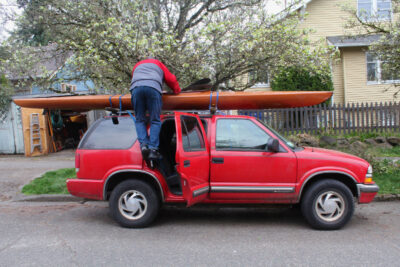
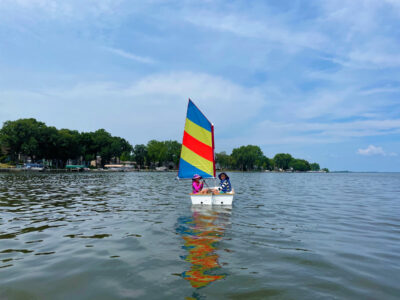
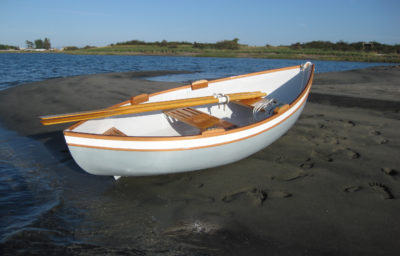
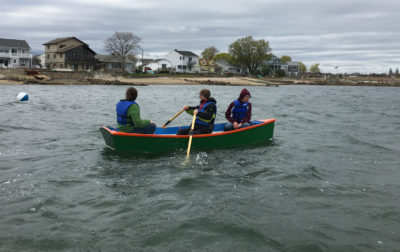
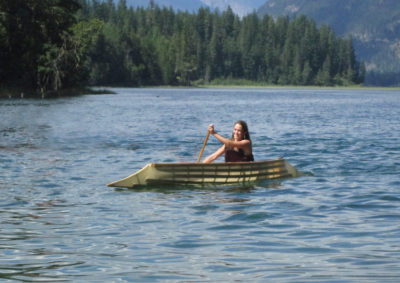

Great Job… I see you getting undue influence to build another… May I suggest a name:”Three Sheets to the Wind”